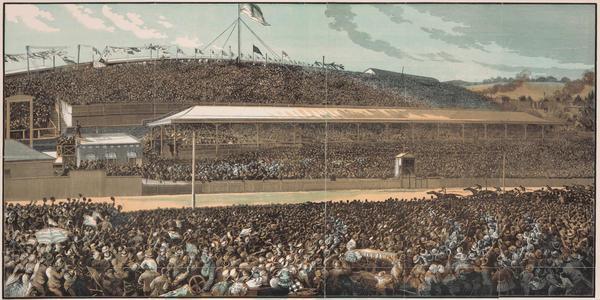The City of Melbourne
Melbourne spreads around over an immense area of ground. It is a stately city architecturally as well as in magnitude. It has an elaborate system of cable-car service; it has museums, and colleges, and schools, and public gardens, and electricity, and gas, and libraries, and theaters, and mining centers, and wool centers, and centers of the arts and sciences, and boards of trade, and ships, and railroads, and a harbor, and social clubs, and journalistic clubs, and racing clubs, and a squatter club sumptuously housed and appointed, and as many churches and banks as can make a living. In a word, it is equipped with everything that goes to make the modern great city. It is the largest city of Australasia, and fills the post with honor and credit.
The Horse-Racing Cult
It has one specialty; this must not be jumbled in with those other things. It is the mitred Metropolitan of the Horse-Racing Cult. Its race-ground is the Mecca of Australasia. On the great annual day of sacrifice—the 5th of November, Guy Fawkes's Day—business is suspended over a stretch of land and sea as wide as from New York to San Francisco, and deeper than from the northern lakes to the Gulf of Mexico; and every man and woman, of high degree or low, who can afford the expense, put away their other duties and come. They begin to swarm in by ship and rail a fortnight before the day, and they swarm thicker and thicker day after day, until all the vehicles of transportation are taxed to their uttermost to meet the demands of the occasion, and all hotels and lodgings are bulging outward because of the pressure from within. They come a hundred thousand strong, as all the best authorities say, and they pack the spacious grounds and grandstands and make a spectacle such as is never to be seen in Australasia elsewhere.
It is the "Melbourne Cup" that brings this multitude together.

Dressing For the Occasion
Their clothes have been ordered long ago, at unlimited cost, and without bounds as to beauty and magnificence, and have been kept in concealment until now, for unto this day are they consecrate. I am speaking of the ladies' clothes; but one might know that.
And so the grand-stands make a brilliant and wonderful spectacle, a delirium of color, a vision of beauty. The champagne flows, everybody is vivacious, excited, happy; everybody bets, and gloves and fortunes change hands right along, all the time. Day after day the races go on, and the fun and the excitement are kept at white heat; and when each day is done, the people dance all night so as to be fresh for the race in the morning. And at the end of the great week the swarms secure lodgings and transportation for next year, then flock away to their remote homes and count their gains and losses, and order next year's Cup-clothes, and then lie down and sleep two weeks, and get up sorry to reflect that a whole year must be put in somehow or other before they can be wholly happy again.
National Holidays
The Melbourne Cup is the Australasian National Day. It would be difficult to overstate its importance. It overshadows all other holidays and specialized days of whatever sort in that congeries of colonies. Overshadows them? I might almost say it blots them out. Each of them gets attention, but not everybody's; each of them evokes interest, but not everybody's; each of them rouses enthusiasm, but not everybody's; in each case a part of the attention, interest, and enthusiasm is a matter of habit and custom, and another part of it is official and perfunctory. Cup Day, and Cup Day only, commands an attention, an interest, and an enthusiasm which are universal—and spontaneous, not perfunctory. Cup Day is supreme—it has no rival. I can call to mind no specialized annual day, in any country, which can be named by that large name—Supreme. I can call to mind no specialized annual day, in any country, whose approach fires the whole land with a conflagration of conversation and preparation and anticipation and jubilation. No day save this one; but this one does it.
In America we have no annual supreme day; no day whose approach makes the whole nation glad. We have the Fourth of July, and Christmas, and Thanksgiving. Neither of them can claim the primacy; neither of them can arouse an enthusiasm which comes near to being universal. Eight grown Americans out of ten dread the coming of the Fourth, with its pandemonium and its perils, and they rejoice when it is gone—if still alive. The approach of Christmas brings harassment and dread to many excellent people. They have to buy a cart-load of presents, and they never know what to buy to hit the various tastes; they put in three weeks of hard and anxious work, and when Christmas morning comes they are so dissatisfied with the result, and so disappointed that they want to sit down and cry. Then they give thanks that Christmas comes but once a year. The observance of Thanksgiving Day—as a function—has become general of late years. The Thankfulness is not so general. This is natural. Two-thirds of the nation have always had hard luck and a hard time during the year, and this has a calming effect upon their enthusiasm.
We have a supreme day—a sweeping and tremendous and tumultuous day, a day which commands an absolute universality of interest and excitement; but it is not annual. It comes but once in four years; therefore it cannot count as a rival of the Melbourne Cup.
In Great Britain and Ireland they have two great days—Christmas and the Queen's birthday. But they are equally popular; there is no supremacy.
I think it must be conceded that the position of the Australasian Day is unique, solitary, unfellowed; and likely to hold that high place a long time.